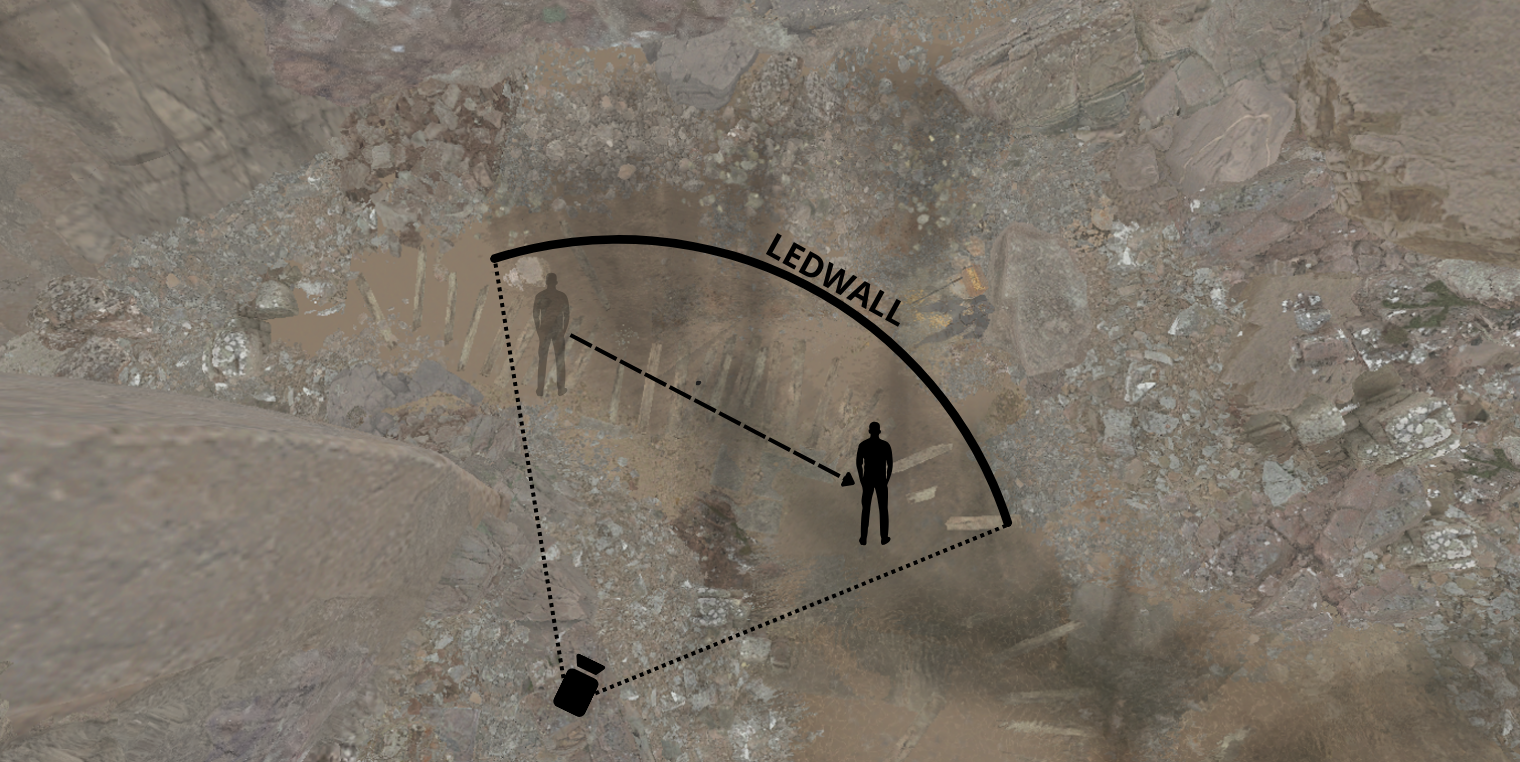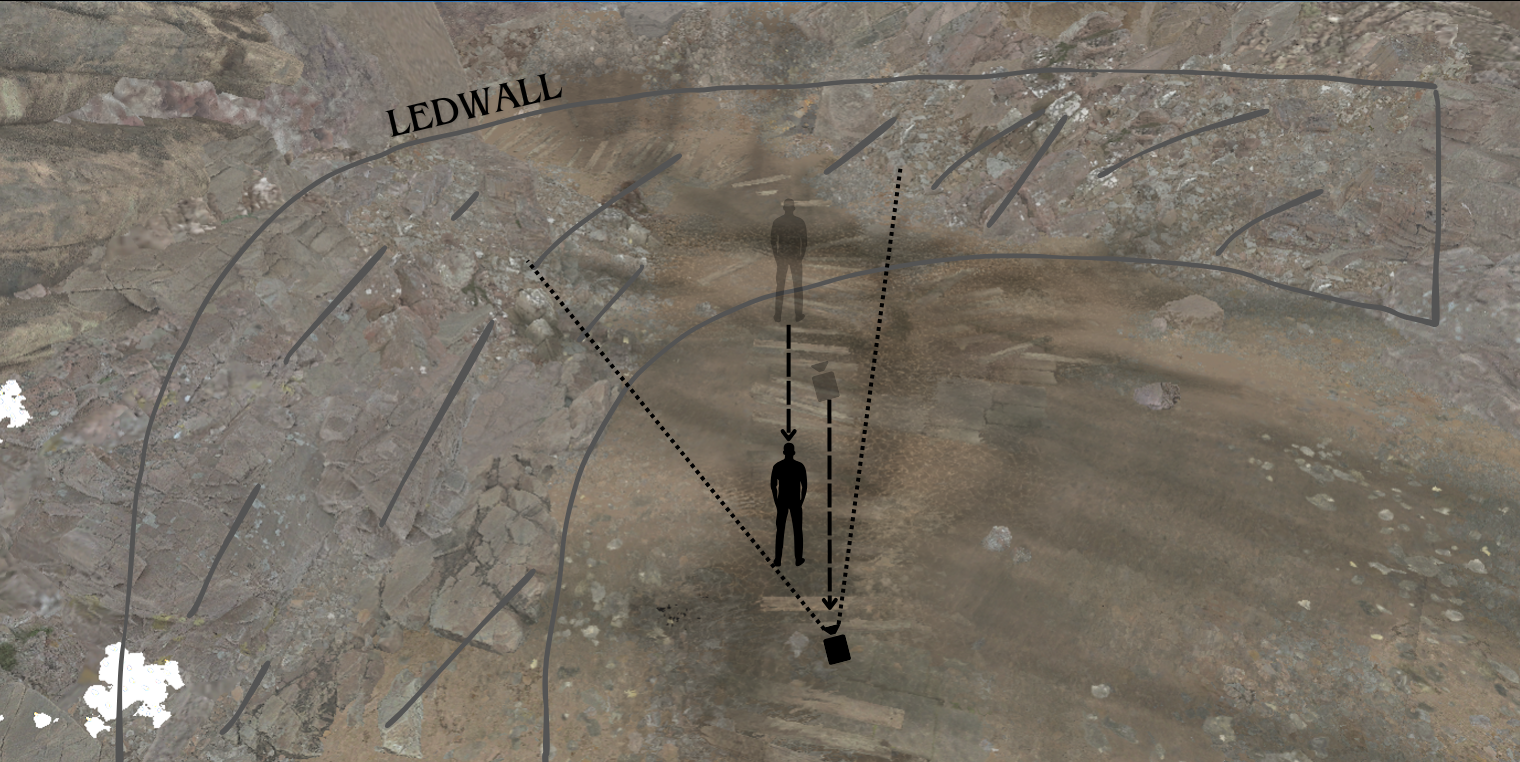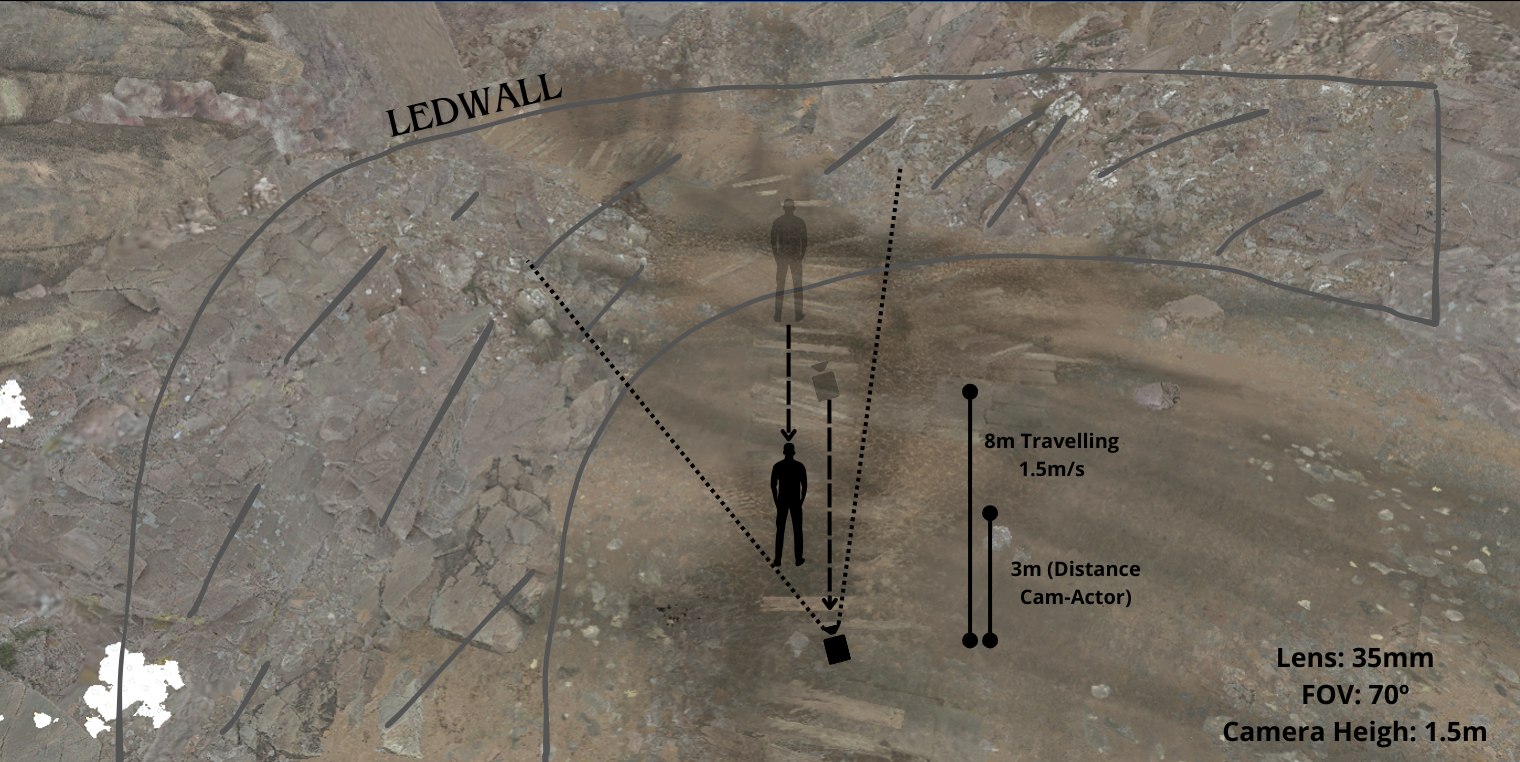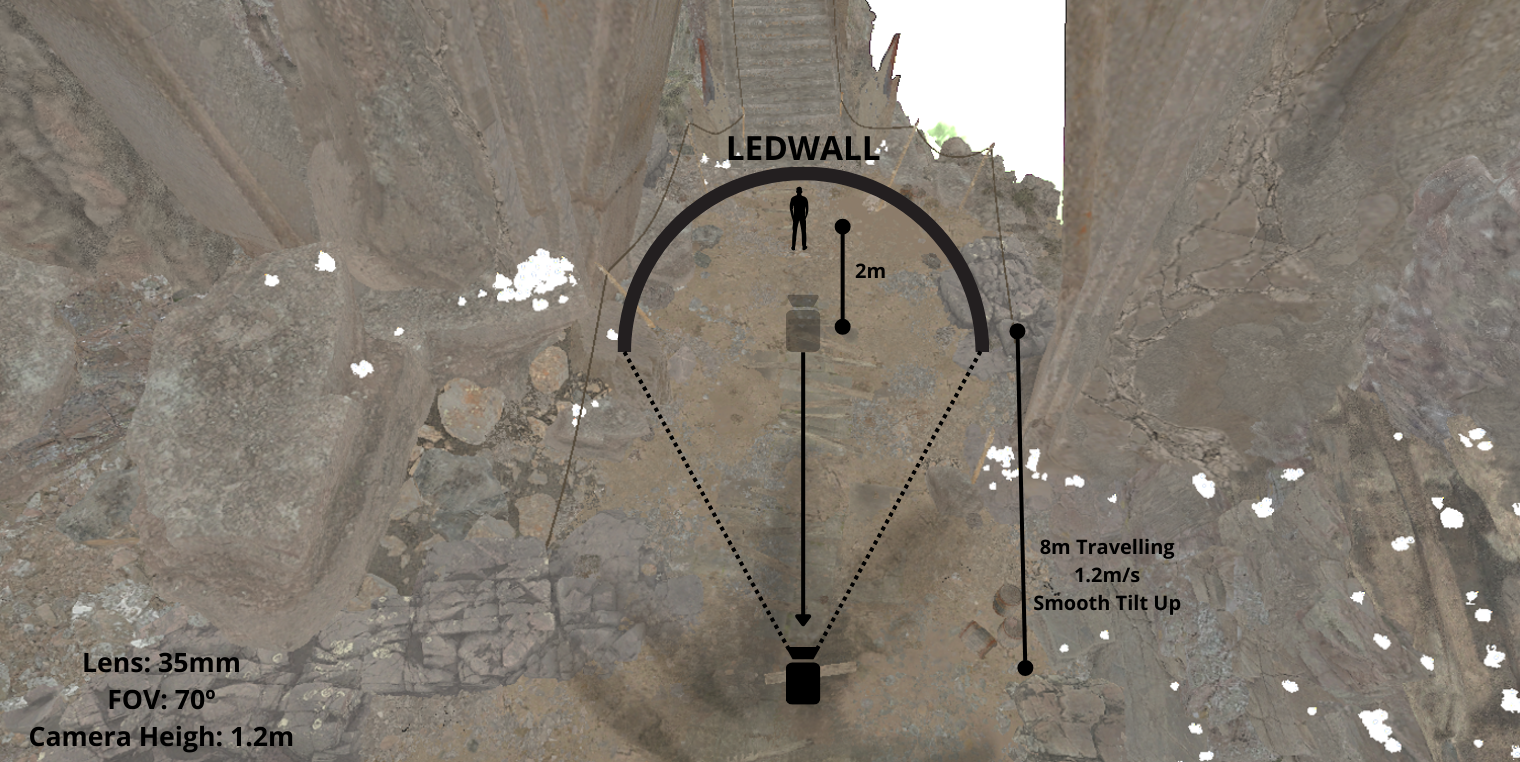about this project
This project, created for the Virtual Production course at RTVE Instituto, outlines the process of creating a previs and techvis for the "La Montaña de los Caídos" scene, detailing the technical and creative challenges of virtual production, including camera movements, LED wall integration, and lighting, with solutions to address technical issues like moiré and banding.
Scene Introduction
The scene takes place inside an ancestral cavern hidden inside a mountain, a place shrouded in legends about its connection to the afterlife. Our protagonist, a traveler desperately seeking answers about his deceased brother, arrives at the heart of the mountain guided by ancient tales. The cave, illuminated by cracks in the rock that let in beams of light and by torches lit along the walls, creates a mystical and eerie atmosphere.
Moving forward, the protagonist discovers what looks like an entrance to a mysterious temple. From the gloom emerge corridors and stairways carved into the stone, leading in multiple directions, as if the place hid a forgotten subway city. On the lower level, an abyss covered by a thick greenish fog extends as far as the eye can see, making it impossible to see the bottom. Suddenly, the cavern shudders with a small earthquake, causing fragments of stone to fall from the ceiling and raising dust into the air. In the misty void, spectral shadows emerge, floating in the air like entities trapped between two worlds. The traveler is faced with a crucial decision: move forward and unravel the mystery or turn back and flee the unknown.
For the scene, a real actor will play the protagonist, while special effects will include dust particles, beams of light filtering through cracks in the cavern and small rock falls as the character passes through. As physical props, rocks, real torches and wooden fences will be incorporated to interact with the lighting and fit naturally with the projection of the curved LED screen, which will expand the depth of the stage and bring to life the atmosphere of the environment.
Previs (Preview)
Previewing is a process in which visual representations of scenes are created prior to their realization. This method allows directors and creative teams to see an animated draft of planned sequences.
Benefits of previs
Early Visualization: Provides a clear idea of how the scene will look, helping to define the visual style.
Narrative Testing: Allows you to explore different narrative approaches and adjust the script if necessary.
Shot Planning: Helps determine camera placement and shooting angles.
Techvis (Technical Visualization)
Techvis focuses on the technical side of the production. It is the bridge between the creative previsualization and the technical execution on set.
Benefits of Techvis
Visual Effects Planning: Determines how visual effects will be integrated with practical elements.
Team Coordination: Facilitates communication between technical and creative departments.
Resource Optimization: Allows foreseeing and solving technical problems before they arise on set.
Technical Challenges during the Shooting
1. Camera and Actor Space
Challenge: Space within the studio can be limited for camera and actor movements, which can affect shot composition and natural movement.
Solution:
- Prioritize medium and American shots (above the waist/knees) to avoid showing the studio floor and reduce the need for physical props.
- Optimize camera movements with markings on the floor to prevent the actor from leaving the usable space.
- If it is necessary to include the floor in shot, consider a physical extension with props or work with VFX in post production.
2. Moiré Effect on LED Screen
Challenge: Moiré can appear when the LED screen resolution and camera sensor resolution are not well synchronized, generating unwanted visual patterns.
Solution:
- Avoid overly sharp lenses or high resolutions that enhance the effect.
- Apply a slight background blur with a shallower depth of field to soften the image without losing detail.
- Adjust the focal length and camera angle to reduce the interaction of the LED pixels with the camera sensor.
- Perform tests with different camera settings before shooting to find the ideal balance.
3. LED Wall Banding Problems
Challenge: Banding appears when the number of bits is not enough to cover all the color palette we need in image.
Solution:
- Use high quality LED displays with good calibration to avoid these effects.
- Adjust gamma and color depth values in the camera to soften gradients.
- If necessary, correct in postproduction applying a slight dither to eliminate banding.
4. Lighting and Scene Consistency
Challenge: Since this is a dark cavern, the external lighting can clash with the natural light generated by the LED Wall, affecting the scene's believability.
Solution:
- Take advantage of the natural light from the LED Wall as the main source of illumination on the actors.
- Implement practical lights on stage, such as candles and beams, to improve visual coherence.
- If additional lighting is required, use soft, diffused lights so as not to generate harsh shadows that give away the studio lighting.
- Perform color balance tests so that the light temperature of the LED Wall and the physical lighting are consistent.
Developed Competencies
- Scene Visualization and Technical Planning: Ability to translate narrative concepts into precise visual and technical plans, combining creative previs with detailed techvis layouts.
- Problem Solving in Virtual Production: Identification and resolution of technical challenges such as camera space limitations, LED screen moiré and banding effects, and lighting consistency in virtual environments.
- Camera and Lens Configuration: Proficient in determining optimal lens, FOV, and camera movements (travelling, pan, tilt) for immersive storytelling within LED volume constraints.
- Workflow Optimization: Efficient planning of resources, actor positioning, and camera paths to ensure a smooth production process with minimal post-production overhead.
- Visual Effects Integration: Strategic planning for the inclusion of VFX (particles, light beams, falling rocks) ensuring seamless interaction between physical props and digital elements.
- Lighting Design and Consistency: Ability to balance LED wall lighting with physical lights to maintain visual coherence and enhance scene realism.
-
Technical Communication: Creation of detailed diagrams and techvis visuals that bridge the gap between creative vision and technical execution, ensuring coordination across departments.








